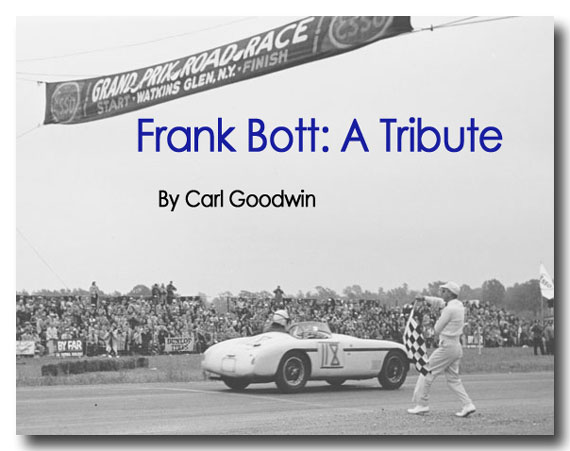 Frank Bott sails over the start/finish line as Nil Mickelson waves the checkered flag. Frank has just won the Queen Catharine Cup at the 1954 Watkins Glen race. Photo by Alix Lafontant.
Frank Bott sails over the start/finish line as Nil Mickelson waves the checkered flag. Frank has just won the Queen Catharine Cup at the 1954 Watkins Glen race. Photo by Alix Lafontant.
There was a driver from Chicago, not as well known as he should have been. But long before Kimi Räikkönen, they called him the “Ice Man” – for he was as cool as could be out on the track. Racing driver Frank Bott died November 25th, 2011 and we followed the rumors until we confirmed it recently. He was born on August 25th 1921. He was one of the sport’s more under-rated drivers.
During World War II, Frank was an air transport pilot. Afterward he worked as a service mechanic at the Mercedes-Benz distributorship of importer Max Hoffman.
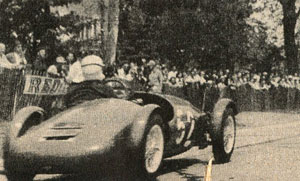
Bott at Bridgehampton in 1952, where he won the Mecos Trophy with his OSCA S/N 1112. Photo credit Bill Harkins.
In the immediate postwar years, Frank became interested in circle track racing and then moved on to sports cars. He knew TV personality Dave Garroway through the Chicago Region of Sports Car Club of America. Garroway had an early Jaguar, an SS 100, and he wanted a little more performance for it. So Frank installed a twin-cam XK 120 engine. Garroway was going to race it at Elkhart Lake in 1951 but was called back to New York for contract renewals. Frank said “I’ll put it back in storage then.” And Dave replied “Oh no, Frank, you race it.” Frank placed second ahead of all the XK-120s except that of Roger Wing.
He made the acquaintance of Rees Makins, who had a chemical manufacturing plant in Chicago. Rees was just learning how to drive and he had an Italian Cisitalia coupe. With its modified Fiat 1100 engine, it ran in the G-Modified class. Rees and Frank drove it in the first 12 hour race in the U.S.A. – not Sebring but Vero Beach, March 8, 1952. But they didn’t get a trophy.
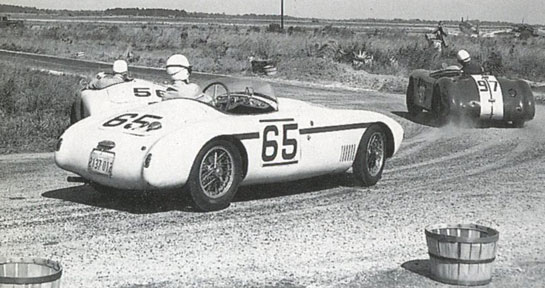
At Sebring in 1954, Bott is seen driving around the sliding OSCA of Stirling Moss, who would eventually win the event. Bott finished first in class, driving OSCA chassis number 1132. Photo credit Bill Foster.
“Tell me what I can get to win races,” Rees said to Frank. The reply was “I told him to buy several European sports car racing newspapers and start reading. Most of the results were the same: OSCA – first, first, first in the under 1500cc class,” Frank repeated.
“Where can I get one of these OSCAs?” Makins asked. Bott knew Edgardo Fronteras, who was the general manager for Max Hoffman’s Jaguar-Porsche operation in Chicago and still had connections with Maserati and OSCA. “After several phone calls to Bologna, Italy, a deal was made for a 1090cc cycle fendered sports car with the chassis number 1112.” Bott said. “When the deal was made, I requested that they also supply all the rear axle gear sets from 3.9 to 5.0 so I could set up the car for almost every course we planned to run.”
It arrived at the docks in New York. It was the first OSCA in the United States. They put it on a trailer behind a Pontiac tow car and headed for Chicago where Makins had a business meeting. Only a short way onto the Pennsylvania Turnpike, Rees pulled over to the side of the road. He was eager to drive the new car…which he did until pulled over by the Highway Patrol. After a short trip to the local judge, in which money was exchanged, they continued on their way.
Not long after arriving in Chicago, they turned around and went back the other way, to Bridgehampton. People would drive a long, long, way in those days, because sports car courses were few and far between. Rees Makins practiced at the 1952 Bridgehampton race but, to race official John Fitch, his driving was erratic. Rees asked if Bott could drive the car instead. Fitch knew him from other races and agreed. He drove against Max Hoffman in the Glockler Porsche, forerunner of the Spyder. Pressured by Bott, Max spun out, then Frank went on for the win. After the race, Fred Egloff notes, Hoffman sent his mechanic down to see who had won the race and discovered that Frank worked for his Chicago Mercedes-Benz distributorship, also as a mechanic. The next week, a memo went out: “employees of the company will not race any car that is not sold by the company.”
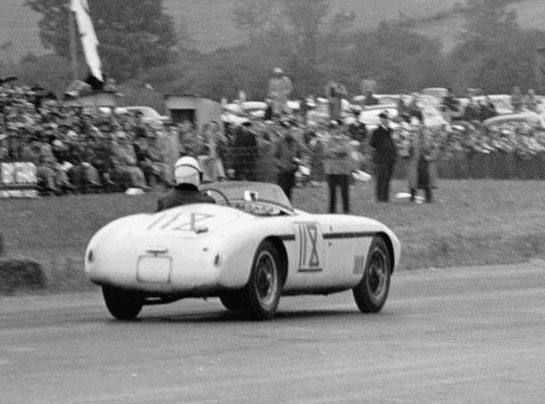
At speed in OSCA #118 at Watkins Glen in 1954. The crowd is packed as Frank Bott easily heads for the win. This is also chassis 1132 which he drove at Sebring. Photo by Alix Lafontant.
However, this was a dictate that Frank ignored. In racing he did not have a strategy, such as waiting until the last lap or two before making the pass. His philosophy is described in the Speed Age account of his 1954 win at Watkins Glen: “Very early in the first lap, Frank Bott, driving the Rees Makins OSCA, took the lead and held it to the checkered flag.”
In 1953 and 1954, Rees Makins won the Class G National Championship, while Frank prepared the car. At Sebring in 1954, Makins and Bott won the 1100cc class (G), while other OSCAs won overall, in Class F, and the top four places in Index of Performance.
Later, in the inaugural 1955 race at Road America, Frank faced off against the formidable Eddie Crawford in a brand new Porsche Spyder. Bott would be driving a 1500cc OSCA Mt4 borrowed from Phil Stewart. Frank took the lead on the second lap and held it to the end. This was one of the last major races in which an OSCA beat a Porsche Spyder, as the German automaker increased the horsepower of the four-cam engine and improved the handling. Briggs Cunningham was third, also in an OSCA.
Chicago Region Historian Henry Adamson notes “Frank was very well liked in Chicago, by many of the major figures including Hal and Bill Ulrich, Art Bly, Ted Boynton, Phil Stewart, Dave Uihlein, Fred Wacker, Jim Kimberly, Fred Egloff and even Wally Mitchell. He could have any ride he wanted. He could have joined the Cunningham team – Cunningham offered him a seat. But instead we, the Chicago Region, sent him Eddie Crawford, another outstanding driver.”
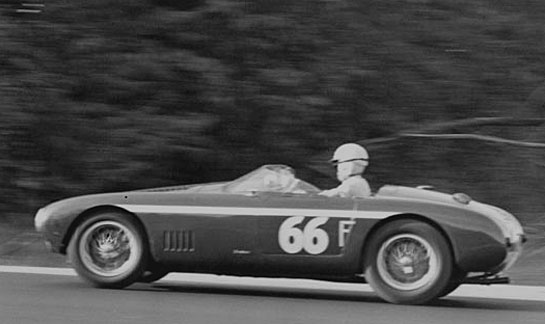
It's the first-ever race at Road America -- 1955 -- and Frank Bott is cruising along, well ahead of Ed Crawford in his Porsche Spyder. He is driving Phil Stewart OSCA 1450 MT 4. Photo by Alix Lafontant.
Fred Egloff recalls a time at the 1956 Sebring when Bott took the 1500cc OSCA out in practice, while Juan Manuel Fangio was driving the Ferrari. After Frank came into the pits, Fangio came in looking for him. Briggs Cunningham was concerned that Frank did something to offend the Maestro but Fangio said he just wanted to congratulate him on his driving.
Late in the 1956 season, the second race at Road America, September 9th, Frank was asked by Ernie Erickson to co-drive a 6 hour race in Ernie’s D-Type Jaguar. Frank started back in the field because grid positions were determined by engine size and the Corvettes and Allards started first. After the usual first-lap collisions, Frank worked his way into first place and, after three hours, handed the car over with a two-minute lead. Ernie experienced a flat tire during his stint and ended the race in third place with John Kilborn and Howard Hively winning in a 4.5 Ferrari.
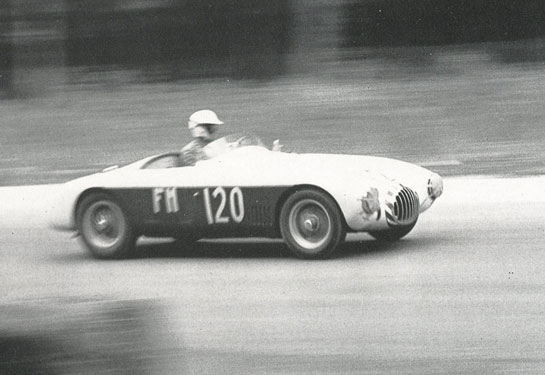
Bott at Road America in 1956 with Jack Furst's OSCA. He was one of the few OSCA drivers who beat the Porsche 550s. Photo by Tony Boynton.
In both 1957 and 1958, Frank drove for the Porsche factory at Sebring. Fred Egloff recalls the first year that Frank drove for the German team. “When he came in off the track, team manager von Hanstein congratulated him. ‘You lapped faster than Ken Miles did,’ he said.” Bott was offered a chance to try out for the Porsche team but decided to decline because by that time he was well-situated in his career.

At Sebring in 1959 Bott co drove this OSCA with Ricardo Rodriquez. Photo courtesy of Sebring International Raceway.
If you knew Frank, he would send you letters with funny headings. One of his favorites said “I want to die in my sleep like my grandfather, not screaming and yelling like the passengers in his car.” He liked keeping in touch with his old friends in racing and often went back to Road America and to the annual Harry Miller Club reunion at the Milwaukee Mile, plus Bob Merrifield’s Sports Car Spaghetti Bash.
After working in Chicago for most of his life, Frank moved out to California where he worked for Charlie Hornberg’s Jaguar business, as service manager for the whole West Coast.
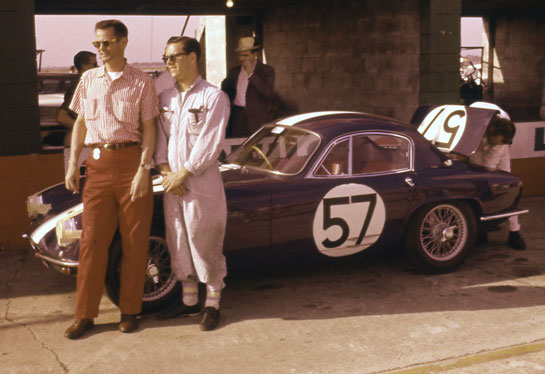
Frank Bott left, and most likely his co-driver Phil Forno with the Lotus Elite they drove at Sebring in 1960. Photo courtesy Willem Oosthoek.
Frank Bott’s last ride in a racing car – the last time he put on a racing helmet — was at the Harry Miller Club reunion at the Milwaukee Mile in 2005, only seven years ago. Many of his racing friends were there, including Fred Egloff, longtime editor of SCCA’s Chicago Region newsletter. Fred rounded up a two-passenger pre-war Indy car and asked Frank “how’d you like to go for a ride.?” Frank put his walking cane in the car, took a seat and off they went. Egloff is no slouch at the wheel, with many racing victories in his pre-war BMW 328 sports car. For a couple of laps they toured the mile-long track at racing speeds and then came into the pits. With the engine off, Fred looked at the cane and said “You never hit me once.” Frank smiled and said “Why should I?” Coming from Frank Bott, that was high praise indeed.
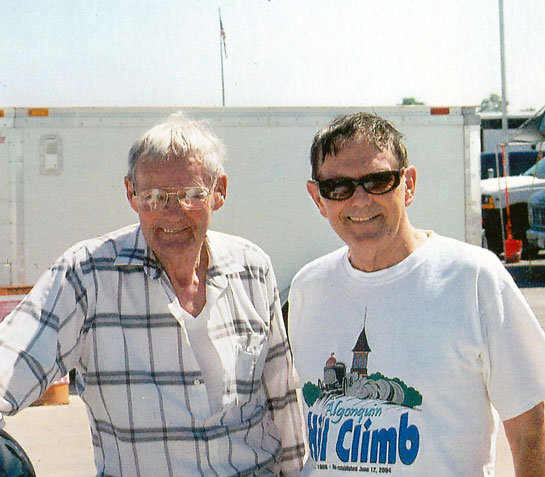
Frank Bott and Fred Egloff at Milwaukee Mile, two old friends from the Chicago Region of the Sports Car Club of America. Over the years they had a great time in racing. Courtesy Fred Egloff.
While actively racing, Frank drove seven times at Sebring. In addition, he drove at Chanute AFB, Watkins Glen, Bridgehampton, Elkhart Lake, Road America, Vero Beach and Lawrenceville Airport. He drove for Ernie Erickson, Briggs Cunningham, the Porsche team and other car owners, with many wins to his credit. To Frank, what was the point of coming in second? His friends in racing will miss him.
Race Record below
__________________________________________________________
The author would like to thank Ken Breslauer, John de Boer, Tony Boynton, Willem Oosthoek and Fred Egloff for their help.
__________________________________________________________
Race Dates and Car Numbers for Frank Bott
1951 Elkhart Lake 8-26-51 Jaguar SS-100 #31…2nd to Roger Wing Jaguar XK-120
1952 Vero Beach 12 Hours 3-8-52– G-Modified Cisitalia coupe #47 with co-driver and owner Rees Makins they finished 13th overall, with 166 laps
1952 Bridgehampton 5-24-52 OSCA #52, 1st over Max Hoffman Glockler Porsche (#48)
S/N 1112.
1952 Elkhart Lake 9-6-52 Jaguar XK120 9th Elkhart Cup race
1952 MacDill AFB, 2-21-53 OSCA S/N 1112, 3rd oa index with Rees Makins
1953 Sebring 3-8-53 1342cc OSCA #6 co-driver/ Rees Makins… S/N 1112
1953 Janesville 8-21-53 OSCA 1112 3rd o/a (1st/ Gm) Race 5
1953 Thompson 9-6-53 OSCA 2nd (or 3rd?) Race 2
Frank Bott tied for 107th (tie with Jim Pauley) in 1953 SCCA National Points Standings
1954 MacDill AFB 1-31-54 Tampa, FLA Races OSCA #77 1st/ Gm (101mph trap)
1954 Sebring 3-8-54 1092 OSCA #65 co-driver/ Rees Makins…1st in CL G/8th OA S/N 1132
Bott gave General LeMay a ride around the course at Bergstrom AFB 3-28-54
1954 Lockbourne 8-8-54 #73 OSCA, 1 in class, S/N 1137 Cunningham’ Sebring OSCA
1954 Chanute AFB 6-6-54 1485cc OSCA #48 SN 1132…1st F-Mod, Second Race
1954 Watkins Glen 9-18-54 OSCA 1132 #118 1st OA Queen Catherine Cup, 1st in Class GM…
Frank Bott finished 11th in 1954 SCCA Fmod National Point Standing with 1500 points
1955 Milwaukee State Fair, 7-4-55 OSCA GM entry
1955 Road America 9-10-55 OSCA #66, 1st…2nd Porsche Spyder, Ed Crawford, #69
OSCA is Phil Stewarts 1450 MT4..probably S/N 1145
Frank Bott finished in a 5-way tie for 13th in 1955 SCCA Fm National Point Standing with 1000 points
1956 Sebring 3-24-56 1485cc OSCA #44 co-driver Rees Makins/entrant Automobile OSCA SPA…entry withdrawn
1956 Lawrenceville Airport 6-10-56 1485cc OSCA #137…2nd in F-Mod, to Ed Crawford, Porsche Spyder #69
1956 Road America 6-24 -56, DNF OSCA #120 Car of Jack Furst
1956 Road America 9-8-56 4 Hour Race, Lotus 11-Maserati #59, DNF broken halfshaft, co-driver Briggs Cunningham
1956 Road America 9-8-56 6 Hour Race 3rd in #27 pale yellow D-Jag of Ernie Erickson
1957 Sebring 3-23-57 1498 Porsche RS #42 co driver and entrant NJ Scott, Houston, Texas…DNF @ lap 168
1957, Eagle Mountain 3 Hours, 10-27-57 Maserati 200SI [chassis 2414] with Bob Ferguson, 4th overall and EM1
1958 Sebring 3-22-58 1498 Porsche RS #74 co driver and entrant NJ Scott, Houston, Texas…4th in CL F and 39th OA
1959 Sebring 3-21-59 1089cc OSCA #56, co-driver Ricardo Rodriguez, Automobile OSCA…5th in CL G and 47th OA NART entry, S/N 951
Bott: “I lost it in a flooded corner and slid off the course into a muddy field. The car was OK, but I couldn’t unstick it in the thick mud, so we were out of the race. What a super car it was too…. The Sebring book says that Bruce Kessler was the co-driver but, I assure you, I was, he wasn’t.”
1959 Galveston, 6-28-59 Austin-Healey 100, DP1 twice
1959, Midland, Tx. 10-11- 59 Austin-Healey 100, DP1 twice
1960 Sebring 3-26-60 1220 cc Lotus Elite #57 no co-driver, entrant Lotus Cars USA…DNF @ lap 57
1960 Oklahoma City, 11-6-60 Austin-Healey 100, DP1
Note: This list is probably not complete. If you can add to it, let us know.
Note: Serial numbers may not be accurate! These are our best guesses.
nice story about frank. a bit before my time, i didn’t know what an osca was until late 1959. in 1958 i was buying my alfa parts @ mr. hoffman’s garage in manhattan, i might have met him there without knowing who he was.
rees makins sloppy driving?
in 1960 their 1.5 osca was stuffed into a sandbank @ the end of the warehouse straight. i watched it for 4 or 5 laps at the rate of 4 min/lap. they ended up with one fewer laps than my 750. i have always wondered who was driving (& digging) @ the time.
> jack
A wonderful tribute to a fine guy. I raced at several events in which he raced, but never in the same race. He always seemed to win his race– I seldom did.
I recall that he always liked OSCAs because they were left hand drive.
Jerry Lehrer
Here are some additional races in the career of Frank Bott:
Oct 27, 1957, Eagle Mountain 3 Hours, Maserati 200SI [chassis 2414] with Bob Ferguson, 4th overall and EM1
Oct 11, 1959, Midland, Austin-Healey 100, DP1 twice
Jun 28, 1959, Galveston, Austin-Healey 100, DP1 twice
Nov 6, 1060, Oklahoma City, Austin-Healey 100, DP1
I think that Frank worked for Overseas Motors in Fort Worth at the time, as a Jaguar engineer.
Best,
Willem
another true talent from the days when it was truly a sport. it’s almost loathsome today with its bureaucracy, stack upon stack of rules, equalization of performance, etc. etc. etc. with the philosophical annoyance to li’l old me of kids racing karts at 5 or 6 years old with the plan of making a great living racing cars. they’re perfectly free to do so; but this brings to mind denise mccluggage telling me that when she interviewed several young men they’d said ‘if i don’t make it to the big time, well, i don’t know how to do anything else.’ just another problem of our first world society!